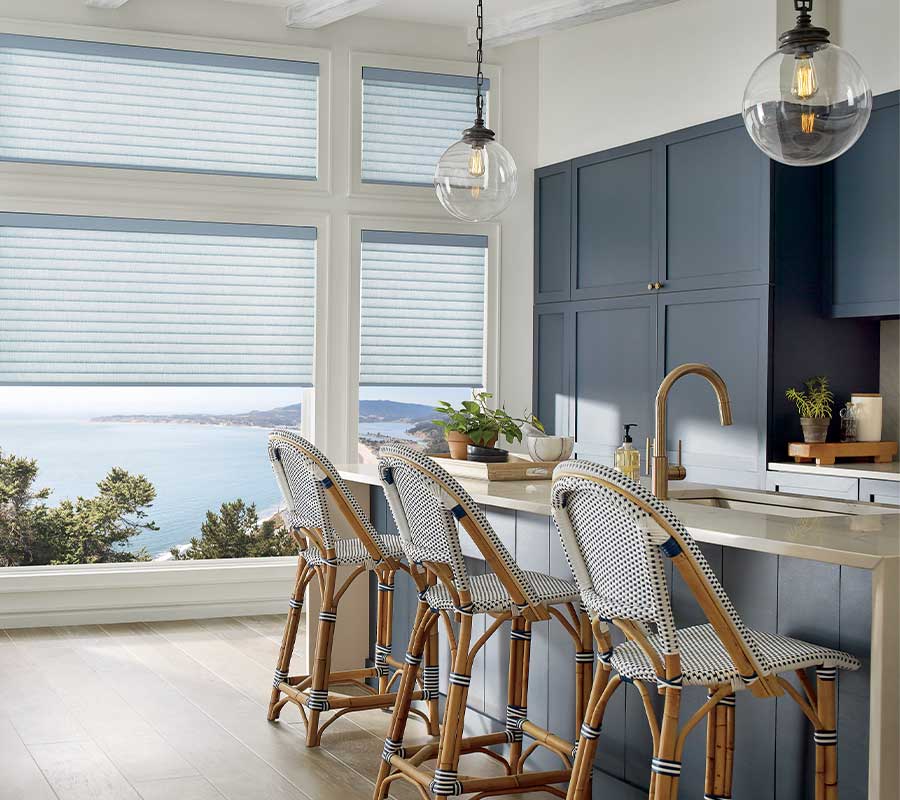It’s that time of year when we need to start thinking of ways to deal with the summer heat. If you’re in need of ways to keep your home cool, look no further than the window treatments! To get to the root of the problem, we are going to explain the three types of heat transfer that occur. Then, we’ll be showing you which energy saving window coverings will work best!
3 Types of Heat Transfer
What exactly is heat transfer? It’s how the sunlight and hot air outside your home cause your home to heat up. Heat transfer causes heat gain. There are three ways this can happen, and your home is under fire from all three!
Radiant Heat:
You don’t normally feel the heat of the sun in the air. Most of the time, you’ll notice surfaces where the sun’s rays are hitting. We call these hot spots. Touch the sunny area, and you’ll feel just how hot things can get. Pets love these cozy spaces for nap time. The problem is that once surfaces heat up inside your home, everything gets so much hotter. The AC is the only way to keep your home cool if you are experiencing heat gain from radiant heat.
Convection:
This type of heat transfer has to do with moving air. Even on a day without much wind, exterior air is moving. That moving air moves to the windows and away from the windows. Cool air is attracted to warm windows during cold weather, and warm air is attracted to cool windows on a hot day. The best solution for this is to put a barrier between the interior air and the window to reduce the heat gain.
Conduction:
Heat is transferred through solid objects. We know this as the “spoon in tea” effect. A cold spoon put in hot tea will not stay cool. Even the part not submerged in the hot tea will gradually heat up. When windows don’t have insulating factors, like the R-value you’ve probably heard of, your home is at risk of heat gain. By adding insulating window treatments, the hot glass of the window will not come into contact with the interior air, trapping it.

Is It Possible to Reduce Heat Gain?
It’s definitely possible, and as you might have guessed, an easy answer is window coverings. Not only do we have firsthand experience with reducing heat gain in our own homes, but we have outfitted a tremendous amount of houses over the years to solve these common issues.

Recommendations for Energy Saving Window Treatments
Our top-of-the-line choices for reducing heat gain are Honeycomb Shades. The cellular pockets hold air, which means the air on the interior won’t be mingling with air from the exterior. This is a great way to insulate your windows. Not only that, but with the right opacity, these shades can also block incoming sunshine which leads to those hot spots your pets love. Sorry, Rover.

One of latest innovations in honeycomb shades is the Sonnette collection of cellular roller shades. The concept is similar–providing insulation at the window while blocking intense light from entering. The unique ability of these shades is that they roll, unlike any other cellular shades on the market.

Well-loved in the design world, homeowners have also been using draperies to prevent heat gain for generations. It’s important to use the right fabrics with custom draperies so you get the best results while also styling your home beautifully. Your window covering specialist will have ideas for you, including the possibilities of adding a liner for extra protection.

Can shutters help keep your home cool? You bet! To begin with, shutters are framed into the window area, creating an area where the heat transfer is slowed because of the barrier that is now installed. Close up the louvers, and you’ll block air flow, as well as radiant heat. Even when louvers are adjusted to let the light in, air doesn’t flow as easily.

One of the most historic types of window treatments, the use of roman shades dates all the way back to…well…Roman times. Folds of fabric cascade down the window. Those fabric layers insulate and prevent air from flowing. They also block the light, so you can keep your home cool. Raise them just slightly to bring in light and create a small hot spot for your pup, and they’ll be happy.

Are sheer shades normally used for energy efficiency? Not exactly. But, while we are on the subject of protecting your home from heat transfer, they definitely do a great job at keeping out direct light! That radiant heat that creates hot spots in your home can be stopped at the window. Entering light is soft and gentle. You might not realize it, but sheer shades actually reflect light on the exterior of your home. So, if you have an area where the direct light is the biggest problem, sheers can be very helpful.

Keep Your Home Cool This Summer!
Don’t let the intense Nevada heat of summer worry you. It’s time to bring in window treatments that will help keep your home cool so you can enjoy it year round! Get in touch with the team at Blue Sky Shutters & Shades for your FREE design consultation.


